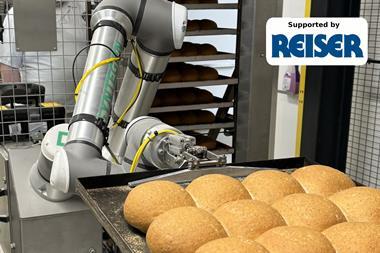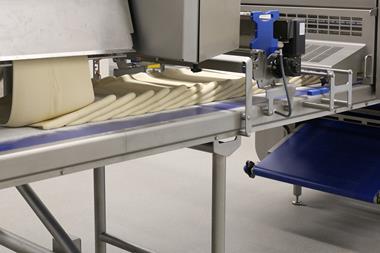Advances in cake and bread cutting technology are helping bakeries meet demand for wider product ranges, while also reducing waste
When it comes to cutting – whether slicing bread or portioning cakes – flexibility is key for many bakers.
Supplier FoodTools recommends buying the cutting solution that covers most of a bakery’s goods at current production levels but gives room for throughput growth.
“We offer several manual and semi-automatic machines for entry-level bakeries and simple machines that can cut round, sheet, and loaf-style products by incorporating different holders for different products,” says FoodTools marketing manager Chris Clemens.
“A small- or medium-sized bakery can list all of its current portion sizes and our engineers will outfit our machines to cut each of them with minimal changeover, returning more value to the bakery.”
The type of product being portioned or sliced will determine the most suitable equipment. Ultrasonic cutters, for example, stop fillings from sticking to the blade and being dragged through a product.
Brook Food supplies the Reach Food Systems Ultrasonic Cutter which works with full-size 18”x 30” bakers’ trays, cutting the entire length with a 760mm blade.
Touch-screen controls can be used to program rectangular and square products of any size within the maximum 460mm x 760mm tray, says Brook, adding that, with automatic trim calculations, the cutter will also slice round cakes, gateaux and tarts, up to a maximum width of 460mm.
It is used at Scottish craft bakery JG Ross’s gluten-free site, as production director Cameron Ross explains: “Gluten-free products are not so easy to cut by hand, so we needed something mechanical. I wanted to cut a 30”x 18” sheet in 100mm squares in a variety of our products, and can now easily change that to 50mm squares with this machine.”
Newtech Intelligent Automation, which specialises in robotic ultrasonic cutting machines, believes flexibility is key.
“Whether you are a low-volume producer of specialist cakes, who needs ultrasonic cutting to handle a sticky product, or a mass manufacturer who needs a machine to ensure accurate portion control across thousands of units of pre-packed quiche, we can build the machine to handle that efficiently and cleanly,” says Newtech managing director Steve Rawlinson.
He adds that Newtech machines use modular systems to minimise downtime for maintenance as a single component can quickly be replaced. “Machines also include a cleaning tank in the operating cell so blades can be cleaned in-situ during a production run to maximise cutting efficiency without incurring long stoppage time or disassembling the unit,” he says.
When it comes to bread slicing, EPP MD Steve Merritt says a continuous band slicer is the answer for high-output plant operations, while a reciprocating blade slicer is suitable for a craft bakery.
“The alternative motion of the blades in a reciprocating blade slicer makes them ideal for use by craft bakers, who do not need the high speed of cut sought by plant and industrial bakers,” he says. “They are usually equipped with an upper and lower conveyor belt that drives the loaf through the blades at an adjustable speed. This also makes them ideal for slicing baked products with dried fruit and chocolate.”
EPP supplies cutters produced by Brevetti Gasparin, including a new bun slicer that can totally or partially cut buns that are then bagged or flow-wrapped in single or double layers tailored to the customers’ specifications.
Such continued innovation by cutting equipment suppliers will help Britain’s bakers maintain their edge.
Wrights: a cut above
Wrights Pies, part of Wrights Food Group, has purchased a Newtech Robo-Sonic cutting machine after increasing volumes at its Crewe factory.
The machine is able to handle out-of-tray product as well as in-tray baked products, according to Alison Harding, retail operations director of Wrights Food Group.
Key features of the machine include: highly accurate trim removal; ability to cut different mediums; one-button programming for recipes; ability to do in-line round or square tray bake cutting; modular construction; in-line blade cleaning system.
“Since installing the Robo-Sonic machine we are regularly recording 100% yield on production,” says Harding.
“With virtually no product waste we are already seeing a significant return on investment on this machine as we are saving the cost of specialist food waste disposal.
“The flexibility and scalability afforded by its modular construction also makes it an excellent long-term investment for us as our business grows.”
Bread slicer sales set to rise at 4.8% CAGR
Global sales of commercial bread slicers are set to rise at a compound annual growth rate of 4.8% in the next five years, according to a new study.
Innovation will be a key driver in the market, states the Global Commercial Bread Slicer Market 2017-2021 report published in May by Research and Markets.
Variable thickness slicers are becoming significantly popular, says the study, as are safety features such as interlocking doors, photo eye sensors, and automatic safety covers to ensure there are no exposed blades.
Many market players are also focusing on introducing quieter models of bread slicers, found researchers, while some are offering commercial bread slicers with round blades that enable oil-free cutting of bread, even when it is warm.
“To enhance end-user satisfaction and expand their customer base, many players are focusing on offering commercial bread slicers with innovative features,” states the report.
Researchers say that one challenge facing the market is fluctuation in raw material prices, which can lead to “significant” reduction of revenues and profitability of manufacturers.
Cake slicing made easy at point of sale
Salador Company has launched a machine to cut bakery products into slices at point of sale.
“It enables any foodservice outlet, where they serve cakes, to cut fresh in front of the customer,” says Salador joint managing director Brian Smith.
The cutter is being targeted at retail bakeries and coffee shops and costs £5,000. The machine uses a 0.4mm wire on soft products such as cream cakes and a blade for items such as walnut cakes, quiches and pies.
The cake cutter, which was showcased at IFE in London in March, has already launched in the US where it has had a positive reception, says Smith.














































No comments yet